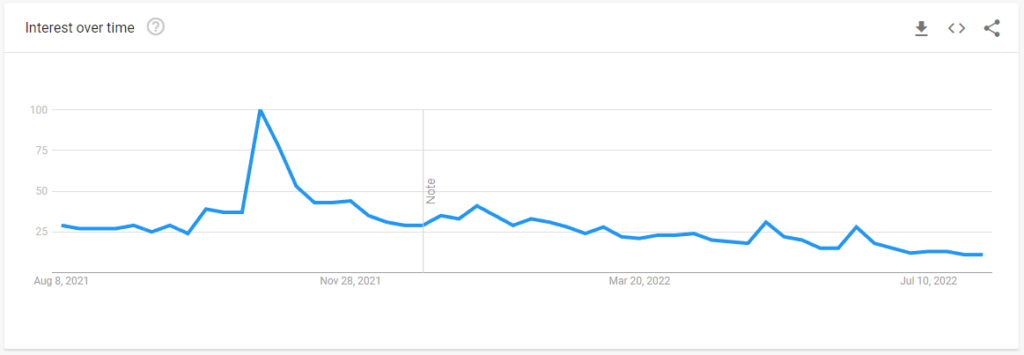The past two months have been relatively uneventful for cryptocurrency markets. Bitcoin and Ethereum have been trading sideways since mid-June, and despite minor bull rallies in July, the market is essentially unchanged. Trading volume is showing a significant drop today, with Bitcoin’s 24-hour volume down over 37% while Ethereum’s is down over 40%. The sharp decrease in trading volume makes sense since today is Sunday, and most traders are taking the day off.
Key Points:
- Cryptocurrency markets remain weak and continue trading sideways as trading volume decreases sharply.
- Bitcoin bears are making their presence known as the underperformance of the digital asset persists.
- Institutional and retail investors remain cautious when investing in crypto markets, preventing a significant bull run.
- Google Trends data suggests an all-time-low interest in cryptocurrency, a significant contributor to weak crypto markets.
Bitcoin Bears Showing Their Presence
With weakening market momentum, the Bitcoin bears are starting to show their presence. A report from Seeking Alpha today outlined several signs that BTC’s outlook is grim. For example, Tesla’s sale of most of its cryptocurrency this year at a loss is a sign that the company doesn’t think Bitcoin will recover anytime soon. Moreover, one of BTC’s most prominent proponents, Michael Saylor, stepped down as CEO after his crypto ventures cost the company close to $1 billion in losses.
With the weak position of the cryptocurrency market, despite its capitalization of $1 trillion, retail and institutional investors are unlikely to risk opening a long-term position for ETH or BTC. That’s one reason for the sharp decline in trading volume and market momentum plaguing crypto for the past several months.
While stocks manage to perform relatively well in the short term, in the grand scheme, NASDAQ, S&P 500, and Dow Jones are down year to date. Inflation is still rising, and the Fed will continue its aggressive monetary policy of increasing interest rates until CPI numbers show a recovering economy. While the Federal Reserve continues to raise rates, stocks will remain under bearish pressure, preventing global markets from exhibiting substantial growth.
On another note, Bitcoin miners have been capitulating their BTC and selling cryptocurrency to cover ongoing expenses. This means even the miners don’t see Bitcoin gaining substantial price in the short-term to justify taking a risk holding their digital assets.
Cryptocurrency Interest Is at an All-Time-Low
Google Trends data for cryptocurrency shows a decrease in interest, currently at an all-time low for the past year.

Source: Google Trends
While we thought March and April were a lousy time for cryptocurrency, the second quarter was even worse, despite small peaks in May and June, which gave traders the false hope that crypto assets would recover to November 2021 peaks.
At this point, crypto enthusiasts, traders, and investors should prepare for the low interest and underperformance of crypto assets to continue through Q3 and Q4 of 2022 and hope for a change in sentiment come 2023.
The state of the economy and rising inflation is a significant drag on crypto assets, despite their inherent resistance to fiat instability. The biggest issue is the lack of new capital flowing into digital assets, causing low trading volume and a weak crypto market.
Bitcoin is currently trading at $23k, managing to hold current support levels but will likely dip below $23k in the next day. Ethereum is struggling to remain above $1,700, trading at $1,690 at the time of writing. The global cryptocurrency market cap remains above $1 trillion, currently at $1.09, down 0.22% in the past 24 hours.
Disclosure: This is not trading or investment advice. Always do your research before buying any cryptocurrency or investing in any projects.
Follow us on Twitter @themerklehash to stay updated with the latest Crypto, NFT, AI, Cybersecurity, and Metaverse news!
Image Source: rissix/123RF

